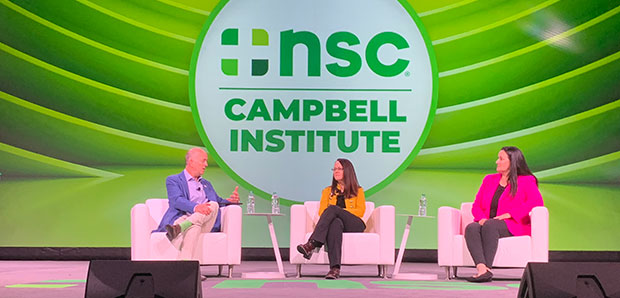
Training the Multi-Generational Workforce
Campbell Institute Forum discusses how to effectively train a workforce comprised of Baby Boom, Generation X, Generation Y and Generation Z workers.
- By David Kopf
- Oct 23, 2023
How do safety trainers meet the spectrum of generations currently in the workplace where they are to deliver impactful, meaningful education? That was the question today’s Campbell Institute Forum panel tackled as part of the NSC Safety Congress & Expo, which runs until Oct. 25 at the Ernest N. Morial Convention Center in New Orleans.
Moderator Taylor Abel, P.E., Director of Driver, Transport and Fleet Safety for United Rentals, interviewed Dow Inc. EH&S Expertise Principal Tamara Coppens and Chemours Company Senior Training Specialist Amanda Ladner to explore the learning differences between generations as well as their commonalities and ultimately what makes for the best approaches.
“Effectiveness of Training Across Generations” took center stage from 11 a.m. to 12 p.m. today, exploring how to do impactful training for the spectrum of age cohorts currently in the workforce: Baby Boomers, Generation X, Generation Y and Generation Z.
At the heart of the discussion was the observation that while safety training remains paramount in reducing workplace incidents, its effectiveness fluctuates across different age groups. Variations in learning styles, attitudes, and preferences necessitate a more personalized approach to ensure that all workers, regardless of their generational cohort, are equipped with the necessary safety knowledge and skills.
While one generation might have learned through lectures and books, and the next had hands-on and roleplay instruction, and further on had e-learning, VR and smartboards, those generations can — and should — help educate each other, Ladner noted.
“Most of all, we learn through interaction,” she said. “We learn through communication with each other, the social beings that we are.”… I try to keep things engaging in the classroom, so really use your more experienced employees to learn from them.
“Use those more experienced operators, technicians, or mechanics to help you develop the training,” Ladner continued. “Then you can take your Gen Z group or your Gen Y group, you tie those experienced coworkers into the training, and they teach back and forth. How amazing is that?”
Also, while there are differences, there are also many fundamental commonalities, Coppens noted.
“For us, as humans, no matter what generation, we learn first when we hear a story,” she explained. “And then, if we could connect with other people at a deep level and talk about that story — what did it mean? What did that mean to me? What did I learn from that? What am I going to do differently? — that is incredibly, incredibly powerful.”
Each speaker brought a unique perspective to the table, emphasizing the significance of understanding and adapting to the diverse learning methodologies preferred by different generations. They collectively stressed that while safety training’s core principles remain consistent, the delivery and engagement strategies must evolve.
The key takeaway from the forum was clear: For safety training to be genuinely effective in today’s diverse workforce, it needs to be both inclusive and adaptive, addressing the distinct needs of each generation while also recognizing there are universal messages and sharing strengths can create impactful safety training.
About the Author
David Kopf is the publisher and executive editor of Occupational Health & Safety magazine.